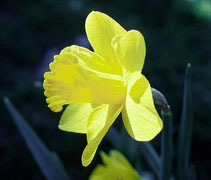


Home
Flowers &
Indoor Plants
Fruits & Nuts
Ornamentals
Vegetables
Special Topics
Resources
Glossary

Daffodil |
 |
What about it? Almost everyone is familiar with the yellow, white, or yellow and white cup-and-saucer-shaped flowers that appear in April to announce the coming of Spring. The daffodil is a bulbous perennial that grows up to 2 feet tall. It is named after the Greek youth Narcissus who fell in love with his own reflection and could not look away. He eventually turned into a flower. What is it used for? Daffodils are used commonly as border plants but can be placed in any visible spot to brighten a blustery spring day. They lend themselves nicely to "naturalizing," or planting in non-landscape areas such as at the edge of the woods. Where does it grow? How do we grow it?Daffodils prefer slightly acidic but well-drained soil, and partial shade. The soil should have some organic matter, and daffodils will benefit from the addition of bonemeal to the soil. Plant daffodils 6-8 inches apart in groups of 6 or more. Double-nose bulbs should be planted in early September, 5-6 inches deep. Allow foliage to mature fully before cutting back. Lift and divide clumps every 3 years in late May (after flowering but while the foliage is still green). Leave 3-4 bulbs per clump and replant immediately. What are its primary problems? The foliage is sometimes slow to mature and the bulb is susceptible to the narcissus bulb fly. How do we propagate it? Offsets bloom in 3-4 years or less; bulbs bloom the spring after they are planted.
© Copyright, Department of Horticulture, Cornell University. |




